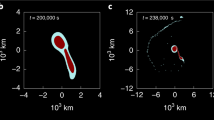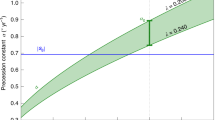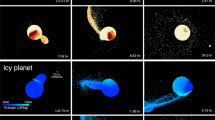Abstract
The two newly discovered1 satellites of Pluto (P1 and P2) have masses that are small compared to both Pluto and Charon—that is, between 5 × 10-4 and 1 × 10-5 of Pluto's mass, and between 5 × 10-3 and 1 × 10-4 of Charon's mass. This discovery, combined with the constraints on the absence of more distant satellites of Pluto2, reveal that Pluto and its moons comprise an unusual, highly compact, quadruple system. These facts naturally raise the question of how this puzzling satellite system came to be. Here we show that P1 and P2's proximity to Pluto and Charon, the fact that P1 and P2 are on near-circular orbits in the same plane as Pluto's large satellite Charon1, along with their apparent locations in or near high-order mean-motion resonances, all probably result from their being constructed from collisional ejecta that originated from the Pluto–Charon formation event. We also argue that dust–ice rings of variable optical depths form sporadically in the Pluto system, and that rich satellite systems may be found—perhaps frequently—around other large Kuiper belt objects.
This is a preview of subscription content, access via your institution
Access options
Subscribe to this journal
Receive 51 print issues and online access
$199.00 per year
only $3.90 per issue
Buy this article
- Purchase on Springer Link
- Instant access to full article PDF
Prices may be subject to local taxes which are calculated during checkout

Similar content being viewed by others
References
Weaver, H. A. et al. Discovery of two new satellites of Pluto. Nature doi:10.1038/nature04547 (this issue)
Steffl, A. J. et al. Brightness constraints on additional satellites in the Pluto system. Astron. J. (submitted)
Stern, S. A., Parker, J. Wm., Fesen, R. A., Barker, E. S. & Trafton, L. M. A search for distant satellites of Pluto. Icarus 94, 246–249 (1991)
Dobrovolskis, A. R., Peale, S. J. & Harris, A. W. in Pluto and Charon (eds Stern, S. A. & Tholen, D. J.) 159–190 (Univ. Arizona Press, Tucson, 1997)
Tholen, D. J. & Buie, M. W. in Pluto and Charon (eds Stern, S. A. & Tholen, D. J.) 193–219 (Univ. Arizona Press, Tucson, 1997)
Durda, D. D. & Stern, S. A. Collision rates in the present-day Kuiper Belt and Centaur regions: Applications to surface activation and modification on comets, Kuiper Belt objects, Centaurs, and Pluto-Charon. Icarus 145, 220–229 (2000)
Stern, S. A. Collisional time scales in the Kuiper disk and their implication. Astron. J. 110, 856–860 (1995)
Mukai, T. et al. Small bodies and dust in the outer solar system. Adv. Space Res. 34, 172–178 (2004)
McKinnon, W. B. On the origin of Triton and Pluto. Nature 311, 355–358 (1984)
McKinnon, W. B. On the origin of the Pluto-Charon binary. Astrophys. J. 344, L41–L44 (1989)
Stern, S. A., McKinnon, W. B. & Lunine, J. I. in Pluto and Charon (eds Stern, S. A. & Tholen, D. J.) 605–663 (Univ. Arizona Press, Tucson, 1997)
Canup, R. M. Giant impact origin of Pluto-Charon. Science 307, 546–550 (2005)
Stephens, D. C. & Noll, K. S. The high fraction of binaries in the cold classical Kuiper Belt. Astron J. 131, 1142–1148 (2006)
Acknowledgements
We thank W. McKinnon, R. Canup and W. Ward for reading and commenting on this manuscript.
Author information
Authors and Affiliations
Corresponding author
Ethics declarations
Competing interests
Reprints and permissions information is available at npg.nature.com/reprintsandpermissions. The authors declare no competing financial interests.
Supplementary information
Background Information
Pluto, the most distant planet in our Solar System, has been known for nearly 30 years to have a moon - Charon - about half as wide as the planet itself. Although some scientists suspected that the planet may have other, smaller moons, at such a great distance from the Earth they would be very hard to spot.
Now two such moons have been seen for the first time. Hal Weaver and co-workers report in Nature that they have found them in images taken by the Hubble Space Telescope. Compared with Charon, the two new moons, called P1 and P2, are tiny. Their exact size is hard to gauge, but reasonable assumptions about their reflectivity indicate that they are both between 48 and 165 kilometres across, compared with Charon's diameter of about 1,200 kilometres. The researchers estimate that P1 orbits Pluto once every 38 days, and P2 every 25 days.
Where did these moons come from? Charon is believed to have formed, like our own Moon, from the debris created when another object slammed into its parent planet. In a second, related paper, Alan Stern and colleagues suggest that a small amount of the material from this impact on Pluto gathered together under its own gravity to form P1 and P2.
The Flash Plugin
You will need the Flash browser plugin to view this video. Download the Flash Plugin here: http://www.macromedia.com/go/getflashplayer
Rights and permissions
About this article
Cite this article
Stern, S., Weaver, H., Steffl, A. et al. A giant impact origin for Pluto's small moons and satellite multiplicity in the Kuiper belt. Nature 439, 946–948 (2006). https://doi.org/10.1038/nature04548
Received:
Accepted:
Issue Date:
DOI: https://doi.org/10.1038/nature04548
This article is cited by
-
Orbit classification in the planar circular Pluto-Charon system
Astrophysics and Space Science (2015)
-
Dynamical capture in the Pluto–Charon system
Celestial Mechanics and Dynamical Astronomy (2012)
-
Evolution of Icy Satellites
Space Science Reviews (2010)
-
Pluto's expanding brood
Nature (2006)
-
Discovery of two new satellites of Pluto
Nature (2006)
Comments
By submitting a comment you agree to abide by our Terms and Community Guidelines. If you find something abusive or that does not comply with our terms or guidelines please flag it as inappropriate.



